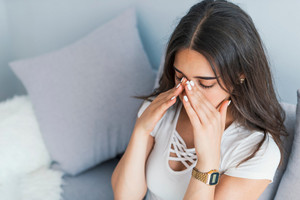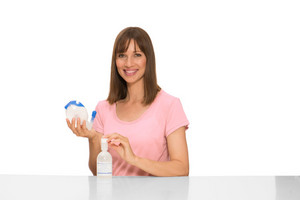
Having inflamed sinuses is usually a very unpleasant experience. Pressure over the forehead and cheekbones is a typical symptom. When you bend forwards, cough or sneeze the pressure often increases. Then your face starts to really hurt. But how can you combat sinusitis and its painful symptoms?
We have put together a summary for you of things that help against sinusitis and its symptoms.
The sinuses are part of the upper airways and are hollow spaces in the facial region. They are divided into the frontal, maxillary and sphenoidal sinuses and the ethmoidal cells. Just like the nose, the sinuses feature a mucosal membrane that permanently forms secretions. This stops fine particles such as dust, dirt or pathogens before they can get deeper into the airways.
If you get a cold, the mucosal membranes in your nose may become inflamed. This can mean that the connection between your nose and sinuses is blocked. The secretions then are unable to properly flow away from the sinus cavities and pathogens can then accumulate there. These can trigger an acute infection of the sinuses.
Once your sinuses are inflamed, you may get a blocked nose and have difficulty breathing. This is often accompanied by an unwelcome headache and facial pain. This ranges from pain in the forehead and eye region, to aching cheekbones and upper jaw, to headaches that radiate round to the back of the head.

Acute sinusitis usually lasts a few weeks before it disappears. Sometimes, however, sinusitis can also develop into a chronic condition. This depends entirely on the body’s immune system, allergic predisposition and anatomical features – such as nasal polyps or a deviated nasal septum. The type of treatment depends on whether the infection is acute or chronic.
The most important thing for most patients is to clear the sinuses because blocked nostrils and headache are very unpleasant.

The use of a nasal douche with natural saline solution is a tried and trusted method to clear mucus from the nose and sinuses. This is because the salt can help reduce the swelling in the mucosal membranes in the nose and let the secretions flow. Pollen and pathogens are also rinsed out of the nose. The PARI Montesol nasal douche is used with its specially formulated nasal rinse solution containing dexpanthenol which also soothes your nose. We also have tips here on how to avoid using the nasal shower incorrectly and so prevent side effects.
Decongestant nose drops or nasal sprays can also help clear mucus from the nose and sinuses. But you have to be careful. Many conventional decongestant sprays can lead to habituation if you use the spray for longer than seven days.
As already mentioned, there are many different causes for chronic sinusitis. The treatment then depends on the actual cause. If it is down to polyps or a deviant nasal septum, surgery can be helpful. If the chronic inflammation is caused by an allergy, it can help to treat the cause. Nasal sprays containing steroids are often used to combat the inflammation.

One of the oldest methods to treat respiratory diseases can also help against inflamed sinuses – inhalation therapy. However, with standard inhalation devices, the inhalation solution only reaches the lower airways. The sinuses, however, are part of the upper airways.
The PARI SINUS2 is a nebulizer system which produces pulsating aerosol. This means that saline solutions or drugs used to treat inflammation can actually reach the sinuses, making this form of nebuliser therapy unique. The PARI SINUS2 can help treat acute or chronic inflammation of the sinuses to relieve symptoms and improve quality of life.
Note: The information in this blog post is not a treatment recommendation. The needs of patients vary greatly from person to person. The treatment approaches presented should be viewed only as examples. PARI recommends that patients always consult with their physician or physiotherapist first.
An article written by the PARI BLOG editorial team.
© 2025 PARI GmbH Spezialisten für effektive Inhalation